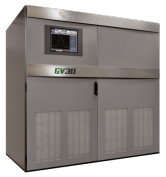Abstract
As authorized HD Radio™ digital injection levels increase, the overall AC to RF efficiency of the typical FM broadcast transmitter is compromised. At the same time, the options for, and use of, high power hybrid solutions (both tube and solid state) have increased significantly since the HD Radio technology rollout began. This presents a challenge to both the manufacturer and the broadcaster to utilize the most efficient cooling techniques available. While FM broadcast transmitters have been traditionally air-cooled, liquid-cooled approaches have also been tried. This paper examines the relative advantages and disadvantages of air vs. water-cooling for high power HD Radio hybrid FM transmitters.
HD Radio™ Transmitter Efficiency
One of the more significant operational costs faced by broadcasters has always been the cost of running the transmitter. This has been particularly true of high power stations. Over the past 20 to 30 years, advancements in both tube and solid state designs have resulted in steadily increasing reliability and efficiency, lowering the costs associated with both maintenance and power consumption. It was dismaying to some broadcasters, therefore, that with the introduction of HD Radio, efficiency would actually go DOWN, and their power bills would go UP, and quite often out of proportion to the incremental amount of RF actually radiated. To produce a digital signal at just 1% of the analog power, we were being told we could expect power bills that were 20-25% higher. This was due, of course, to the different amplifier classes, lossy combining methods, and additional cooling that these transmitter configurations required.
Nautel FM HD Radio Transmitter Cooling Technologies Tradeoffs by Gary Liebisch

